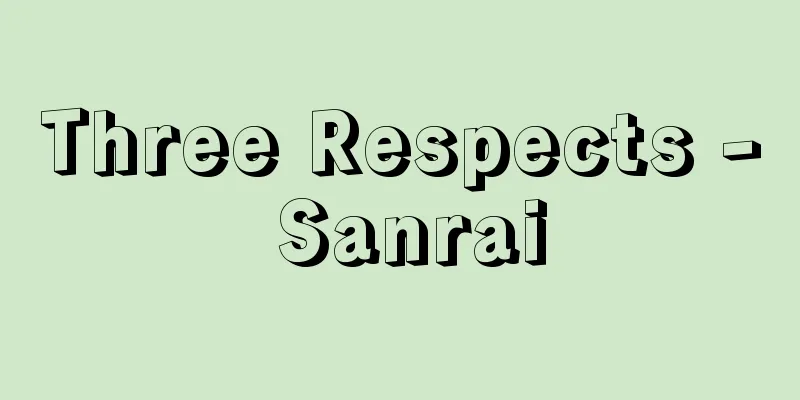Three Respects - Sanrai

("Rai" is the Go-on pronunciation of "ritual") [1] [noun] ① A Chinese ceremony to worship the gods of heaven, earth, and ghosts (the souls of the deceased). [Book of Documents - Shun-setsu] ② A Buddhist term. To kneel and worship three times to show respect for the three actions of body, speech , and mind. Three bows. ※Teishin Koki - Excerpt, August 23, 925, Encho 3 (925), "Eleven monks and the head priest of Enryaku-ji Temple, etc., for those who raise the sutra, perform three or more bows ." ③ Three types of worship. These are the upper bow, in which the head is bowed to the ground while sitting; the middle bow, in which the hands are kneeled down; and the lower bow, in which the hands are clasped in front of the chest and raised and lowered. [Shogenjiko Setsuyoshu (1717)] ④ When carving a Buddha statue, bowing three times for each incision. One sword, three bows . *Miscellaneous Hai, Yanagi Taru, 67 (1815) "Three bows to sharpen a small knife with lotus water" ⑤ Abbreviation of "Sanraishi (three bows master)". *Mido Kanpakuki, Kanko 8 (1011), March 27, "Jugan Jocho Sozu, Narishi Narishu, Sanrei Kaiju, Utakeno Mikoto" [2] [1] A general term for the three books of Zhou Li (Shurai) , Rites (Girai) , and Riteki (Raiki) that describe ancient Chinese etiquette and systems. *Shoku Nihon Koki, Jowa 12 (845), February Dingyou, "Zhenzhen is two three transmissions of three bows, one for work . He is also capable of discussion . " [Nanshi, Denryuden] [2] A chanting song chanted by the Shingon sect. The phrase "All respect..." is chanted very solemnly.San-rei [Three Bows]Source: The Selected Edition of the Japanese Language Dictionary About the Selected Edition of the Japanese Language Dictionary Information |
(「らい」は「礼」の呉音)[1] 〘名〙① 中国で天神・地祇(ちぎ)・人鬼(亡き人の魂)をまつる儀式。〔書経‐舜典〕② 仏語。身・口(く)・意の三業に敬意を表わして三たびひざまずいて礼拝すること。三拝。※貞信公記‐抄・延長三年(925)八月二三日「僧綱十一人・延暦寺座主等為揚御経題人、三礼以上僧綱」③ 三種類の礼拝。すわって頭を地面につける稽首礼(上礼)と、ひざまずいてする跪礼(中礼)と、胸の前で組み合わせた両手を前に出して上下させる揖(ゆう)礼(下礼)の三つ。〔書言字考節用集(1717)〕④ 仏像を彫刻する時、一刻みするごとに三度礼拝すること。一刀三礼(いっとうさんらい)。※雑俳・柳多留‐六七(1815)「三礼の小刀蓮の水で研ぎ」⑤ 「さんらいし(三礼師)」の略。※御堂関白記‐寛弘八年(1011)三月二七日「呪願定澄僧都、読師成秀、三礼懐寿、唄慶命」[2][一] 中国古代の礼儀、制度を記した周礼(しゅらい)・儀礼(ぎらい)・礼記(らいき)の三書の総称。※続日本後紀‐承和一二年(845)二月丁酉「真貞以二三伝三礼一為レ業。兼能二談論一」 〔南史‐伝隆伝〕[二] 真言宗で唱える声明曲。「一切恭敬…」という句をきわめて重重しく唱える。
さん‐れい【三礼】出典 精選版 日本国語大辞典精選版 日本国語大辞典について 情報 |
>>: Sanyo Main Line - Sanyo Main Line
Recommend
Lamium - Let's dance
A perennial plant of the Lamiaceae family (APG cl...
SCOR - Specialist Company
《 Scientific Committee on Oceanic Research 》Scient...
Heymans
Belgian physiologist. Graduated from Ghent Univers...
Palestine
The area refers to the area between Syria and Egyp...
Taira no Shigemori - Taira no Shigemori
Year of death: 29 July 1179 (2 September 1179) Yea...
Ouchi Oban Yaku (Guard of the Ouchi)
…One of the vassals of the Kamakura Shogunate. It...
Mito [town] - Mito
A former town in Mine County in the mid-west of Ya...
Inorganic compound - inorganic compound
This refers to compounds other than organic compo...
Air conditioning (English)
The act of adjusting the temperature, humidity, an...
Fushimi version
Also known as the Enkoji edition. Along with the ...
Masamune
Dates of birth and death unknown. A swordsmith fr...
goliardus
…They are also called wandering monks, but this t...
Mountain Bluebird
...The male of the Western Bluebird, S. mexicana ...
Torpedo - Suirai
A general term for underwater destructive weapons...
Svedberg
Swedish physical chemist. Studied at Uppsala Univ...









